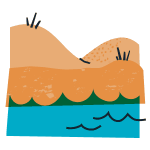The transitional zone between the land and the sea has also become less dynamic due to various damming projects in the past, such as the reclamation of the Kop van Noord-Holland region and the construction of the Afsluitdijk and Lauwersmeerdijk. As a result, the variety of habitats for people, flora and fauna has decreased.
This issue focuses on the unique identity of the Wadden Sea region and the people who live and work there by maintaining and reinforcing the core values of the region: the unique open landscape and its dikes, polders, dwelling mounds, silent areas and dark-sky areas. It also focuses further inland to the extent that a recognisable relationship with the Wadden Sea exists. However, it also involves reinforcement of the brackish transition systems, which provide opportunities for energy transition and improvement of nature quality by means of greater energy conservation and the generation and storage of sustainable energy. The commissioning parties have asked PRW to challenge and encourage the parties involved to organise bottom-up pilots to rehabilitate the transition zones in the interests of nature and sustainable economic development.
Role of the PRW:
Results to be delivered:
- Two innovative area-development processes will have been set up in 2020 (e.g. Lauwersland, Termunten, Kop van Noord-Holland).
- Two pilots that combine the aspects of nature, the economy, landscape and safety (e.g. silt extraction, the Noordpolderzijl scouring basin, freshwater-saltwater and/or dike with foreshores) will have been successfully launched in 2020.
Commissioning parties:
- Ministry of Agriculture, Nature and Food Quality
- Provinces in the Wadden Sea region: North Holland, Friesland and Groningen
- Directorate-General for Public Works and Water Management
- Natural Wadden Coalition
Follow-up action by:
- Provinces in the Wadden Sea region: North Holland, Friesland and Groningen

